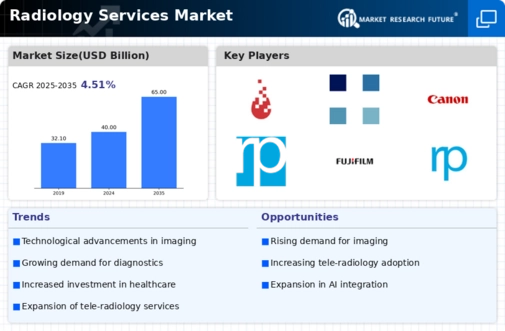Market Growth Projections
The Global Radiology Services Market Industry is projected to experience robust growth over the next decade. With an anticipated market size of 40.0 USD Billion in 2024, the industry is expected to expand significantly, reaching 65 USD Billion by 2035. This growth trajectory is supported by a compound annual growth rate (CAGR) of 4.51% from 2025 to 2035. Factors contributing to this expansion include technological advancements, increasing healthcare expenditure, and a growing emphasis on preventive healthcare. As the demand for diagnostic imaging continues to rise, the radiology services market is poised for substantial development, reflecting the critical role of radiology in contemporary healthcare.
Rising Healthcare Expenditure
The Global Radiology Services Market Industry is significantly influenced by the increasing healthcare expenditure observed across various regions. Governments and private sectors are investing heavily in healthcare infrastructure, which includes the expansion of radiology services. This trend is particularly evident in developing countries, where improved access to healthcare facilities is leading to higher utilization of radiology services. As healthcare spending continues to rise, the market is projected to grow to 65 USD Billion by 2035. This increase in funding allows for the acquisition of advanced imaging technologies and the hiring of skilled radiologists, ultimately enhancing the quality and accessibility of radiology services.
Expansion of Tele-radiology Services
The Global Radiology Services Market Industry is witnessing a transformative shift with the expansion of tele-radiology services. This trend is driven by the need for timely access to radiological expertise, particularly in remote and underserved areas. Tele-radiology enables healthcare providers to transmit imaging studies to radiologists for interpretation, facilitating quicker diagnoses and treatment decisions. As technology continues to advance, the adoption of tele-radiology is expected to grow, enhancing the efficiency of radiology services. This expansion not only improves patient access to specialized care but also optimizes resource allocation within healthcare systems, thereby contributing to the overall growth of the market.
Increasing Demand for Diagnostic Imaging
The Global Radiology Services Market Industry experiences a notable surge in demand for diagnostic imaging services, driven by the rising prevalence of chronic diseases and an aging population. As healthcare providers increasingly rely on advanced imaging techniques for accurate diagnoses, the market is projected to reach 40.0 USD Billion in 2024. This growth is indicative of a broader trend where healthcare systems prioritize early detection and preventive care, thereby enhancing patient outcomes. The integration of artificial intelligence in imaging technologies further supports this demand, as it improves diagnostic accuracy and efficiency, making radiology services indispensable in modern healthcare.
Growing Awareness of Preventive Healthcare
There is a growing awareness of preventive healthcare among the global population, which significantly impacts the Global Radiology Services Market Industry. Patients are increasingly seeking regular check-ups and screenings, leading to a higher demand for radiological services. This shift towards preventive care is supported by public health campaigns and educational initiatives that emphasize the importance of early detection of diseases. Consequently, healthcare providers are expanding their radiology departments to accommodate this demand, thereby contributing to market growth. The emphasis on preventive healthcare not only improves patient outcomes but also reduces long-term healthcare costs, making radiology services a critical component of modern healthcare systems.
Technological Advancements in Imaging Techniques
Technological innovations play a pivotal role in shaping the Global Radiology Services Market Industry. The advent of advanced imaging modalities, such as 3D mammography, MRI, and CT scans, enhances diagnostic capabilities and patient safety. These innovations not only improve image quality but also reduce radiation exposure, addressing safety concerns among patients and healthcare providers. As a result, the market is expected to witness a compound annual growth rate (CAGR) of 4.51% from 2025 to 2035. The continuous evolution of imaging technologies fosters a competitive landscape, encouraging radiology service providers to adopt state-of-the-art equipment to meet the growing expectations of healthcare professionals and patients alike.




















